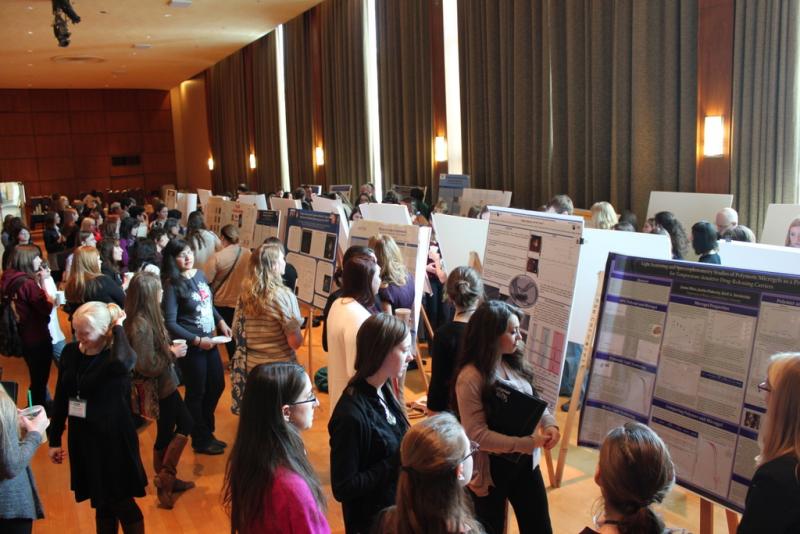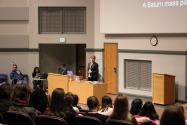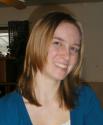Conferences for Undergraduate Women in Physics
January 17, 2014 to January 19, 2014
Penn State University Park, Pennsylvania
Meeting host: By:Kathryn Hasz
SPS Chapter:

Women are underrepresented in physics and related fields. Yet from January 17-19, I was one of over one hundred women pursuing physics with only a handful of men in sight. Penn State hosted the Northeast section of the ninth annual Conference for Undergraduate Women in Physics (CUWiP) and gave women from Pennsylvania, New York, Ohio, New Jersey, and beyond the opportunity to learn more about the current state of physics.
As a senior physics major at Oberlin College, a small liberal arts school in northeast Ohio, I don’t get to see large gatherings of physicists in my day-to-day experience. Seeing such a large gathering of female physicists is even rarer. During my sophomore year, my advisor encouraged me to attend the 2012 CUWiP section at Case Western Reserve University. I encouraged a friend to join me at the 2013 CUWiP section at the University of Illinois. I have loved seeing the growth and evolution of this conference over the past three years.
This year marks another large and successful conference, with about 140 students attending the Penn State site. However, these students were merely a fraction of over one thousand women attending one of eight simultaneous CUWiP conferences throughout the country. While all of us could not attend one central conference, we did come together Saturday afternoon for the keynote address from Dr. Debra Fischer, a professor of astronomy at Yale. She spoke about her work discovering exoplanets at the Penn State conference and her talk was simulcast to the other seven conferences. While the number of women in physics is improving, the sight of over a thousand of us gathered together, even virtually, is pretty powerful.
At the conference a variety of women addressed topics ranging from industry to academia and gave some reflections on their own personal experiences. I particularly appreciated the remarks on gender issues in physics by Dr. Joan Schmelz, a professor at University of Memphis and the current chair of the American Astronomical Society’s Committee on the Status of Women in Astronomy. She presented the ideas of stereotype threat, imposter syndrome, and unconscious bias. She showed there are still hurdles for women pursuing physics. Explicit discrimination is much less prevalent today, but biases still exist that are harder to counter. For example, unconscious bias is an association between a trait and a group made on a subconscious level, such as “scientists are male”. This bias affects both men and women; research has shown that both genders favor a male candidate for a laboratory assistant position (see Moss-Racusin et al. (2012) Proc. National Academy of Sciences). Due to the unconscious nature of such beliefs, they can easily be overlooked in decision-making. Despite the slippery nature of unconscious bias, it must be addressed to create an equal scientific field.
This year’s conference had a variety of workshops to choose from on topics such as networking, summer research experiences and grad school. The workshops were offered in parallel sessions and I enjoyed that format because the small groups enabled more people to have their questions answered and to receive personalized advice about opportunities and pitfalls in physics.
Kathryne Sparks Woodle, a conference organizer and graduate student at Penn State, gave a nice summary of this year’s CUWiP, saying, “Conferences, such as CUWiP, are extremely important in encouraging young women to continue pursuing physics as a career. Not only do they expose students to exciting research while also allowing them to present their own, but they encourage communication and questions about the possible paths to becoming a successful physicist.”
I was one of about ten students who chose to give a ten minute talk at the conference. I really enjoyed explaining my research to an audience. So much time and effort goes into research; it is incredibly rewarding to be able to tell others about your work and have them take interest in it. The other talks that I saw were well presented and helped me understand aspects of topics with which I have very little experience.
Other students presented their research in a poster session. During the poster session I wandered through the posters and talk to the presenters. This was a great chance for presenters to gain experience explaining their work and for non-presenters to learn about research done by our peers in a more informal format.
In addition to hearing talks about research being done by our peers during the conference, we had the opportunity to visit a variety of labs and hear about research going on at Penn State. As someone from a small liberal arts college, seeing some of the larger scale research going on at Penn State was cool.
The chunks of less structured time proved to be especially valuable. During coffee breaks and lunch, I often ended up sitting down at a random table and getting into conversations with people I didn’t know. These conversations ranged from discussing our home departments, to giving/getting advice about REUs and grad school, to the strange antics of squirrels we’ve noticed on campus. We also talked about some of the problems, large and small, that we have faced or expect to face due to being women in a field that is still male-dominated. An excellent outtake of these discussions was Kathryne Spark Woodle’s statement:
Many female physicists have common concerns about their success in the field beyond those pertaining to the science itself. I believe that a key to understanding that one can succeed is realizing that these concerns are not exclusive to a particular individual and acknowledging that we all question our path at some time.
Overall, the Penn State CUWiP was a wonderful opportunity for young female physicists to explore the field and receive encouragement. I hope these conferences can continue to expand and reach more women in physics each year. //
Highlights from Other Sites
Eight sites hosted simultaneous Conferences for Undergraduate Women in 2014. Here are highlights from a few others.
On Nobel laureate William Phillips’ presentation at the Mid-Atlantic CUWiP, hosted jointly by the University of Maryland in College Park and the National Institute for Standards and Technology in Gaithersburg, Maryland:
I honestly cannot remember a time that I have ever been more enthralled, entertained, and educated all at the same time. His demonstrations with liquid nitrogen were completely captivating. He explained how NIST is responsible for measurement standards and discussed his research in cold quantum matter.
– by Rebecca Bissell, Virginia Commonwealth University, Richmond
On a presentation by Luisa Bozano at the CUWiP hosted by the University of California, Berkeley, and Lawrence Livermore National Laboratory:
Bozano’s first “wake-up call” to the gender gap in physics came when she tried to apply for a job in industry in Italy. Her professors told her that companies don’t hire women in science, one of the main reasons being the 6–12 month paid maternity leave required by law if she decided to have a child. For this and several other reasons, she moved to the United States to do research at the University of California, Santa Cruz, where she later received her PhD. Her career at IBM started a year before she got her doctorate. At the end of the talk, Bozano showed us a picture of her baby daughter and said, “This is the one thing I know I did right.” She shared that the day she went to tell her boss she was pregnant was the same day he was going to offer her a management position. Although Bozano was worried about how her pregnancy would affect his offer (based on her experiences in Italy), he said, “I don’t see any problem.” She is now the only female manager in the IBM Science and Technology Center.
– by Kayla Bollinger, California State University, Long Beach
On a tour of Fermi National Accelerator Laboratory (Fermilab) at the CUWiP hosted by the University of Chicago in Illinois and Fermilab:
One of my career goals is to work at a big laboratory such as CERN or Fermilab, so I was excited that the conference offered a visit to Fermilab. Our tour guide explained the history of the facility, the research taking place there, and the benefits of that research. We learned about current developments in neutrino oscillation experiments while visiting the caverns that house the Main Injector Neutrino Oscillation Search (MINOS) detector and the Main Injector Experiment for n-A (MINERvA). After lunch, we continued our tour with visits to the historic Cockcroft-Walton accelerator and the retired Tevatron collider and its DZero detector, used to discover the top quark.
– by Caroline K. Williams, Northeastern Illinois University, Chicago
On a poster session at the CUWiP hosted by Stony Brook University in New York and Brookhaven National Laboratory in Upton, New York:
Thirty-three undergraduate research posters were presented by women to women. Jasmine Abdollahi taught me about using photodiodes to look for neutrinoless double beta decay of radioactive xenon. Kelsie Krafton explained the different types of supernovae while presenting a poster on one supernova’s relevance to early dust evidence. Kelly Blumenthal showed me color printouts of the sky with the same stars appearing in multiple places, distortions caused by galaxy lensing. I presented a poster on my research at Stony Brook with a hadron-blind ring imaging Cherenkov detector. The presentations were lively, and I learned about physics topics ranging from superlattices to tadpoles.
– by Marie Blatnik, Cleveland State University, OH


